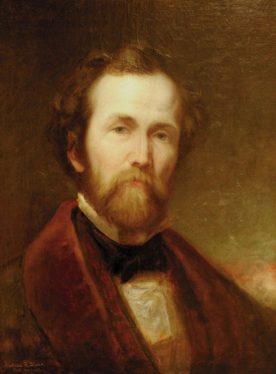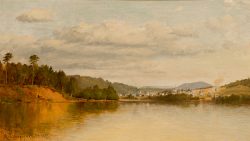Junius R. Sloan, Self-portrait, 1858, oil on canvas (24 by 18 inches), courtesy Brauer Museum of Art, Gift of Percy H. Sloan, 53.01.121.

Junius Sloan 1827–1900
Junius Ralston Sloan was born in Kingsville, in northeastern Ohio, the son of a blacksmith. A largely self-taught artist, he began his career as an itinerant painter of portraits and signs. During a brief stay in Erie, Pennsylvania, in 1848 he may have received some lessons or guidance from local artist Moses Billings. From that date until 1855, Sloan traveled east as far as Vermont and west to Illinois, making portrait drawings and paintings. In Cincinnati in 1850–1851, he met and may have worked as an assistant to landscape painter Robert S. Duncanson, who likely encouraged him to pursue his interest in depicting nature. Sloan opened a portrait studio in Princeton, Illinois, earning enough in two seasons of profitable practice to spend several months in New York City. In 1858, he married Sara L. Spencer, an accomplished calligrapher and a popular teacher of penmanship. For the next several years, they lived variously in Erie, New York City, the Catskill Mountains region of New York, and other locales before settling in Chicago in 1864. By that date, Sloan had given up portraiture to focus exclusively on landscape painting.
The first significant dedicated landscape artist in Chicago, Sloan soon became a member of its small but lively artists’ community, and his work was well-received. Sloan drew his subjects from further tours to upstate New York, but during a summer’s stay at his father’s home in Kewanee, in north-central Illinois, in 1866, he turned his attention to the local setting. His portrayals of the region’s flat scenery are among the earliest serious artistic interpretations of the Illinois prairie, then an unconventional subject for landscape painting.
Sloan left Chicago in 1867 both to have easier access to the classic landscape of New England and to try his fortune in the greater art world of New York. Having honed his skill in landscape painting in ambitious portrayals of such famous settings as Lake George, he returned to Chicago for good in 1873 and opened a downtown studio. Although honored among his fellow artists in Chicago, Sloan found a limited market for his works, especially as consumer taste began to turn away from the detailed, panoramic, and essentially sentimental mid-nineteenth-century style he practiced. Sloan supplemented his income by teaching, sometimes taking pupils with him on his annual sketching excursions. These took him not only back to the familiar scenery of the Northeast but throughout the Midwest as well. Although after the mid-1880s he gave up oils for the less strenuous and increasingly popular medium of watercolors, Sloan continued to create landscapes until his death at the age of seventy-three, while on a trip to Redlands, California.
Wendy Greenhouse, PhD
